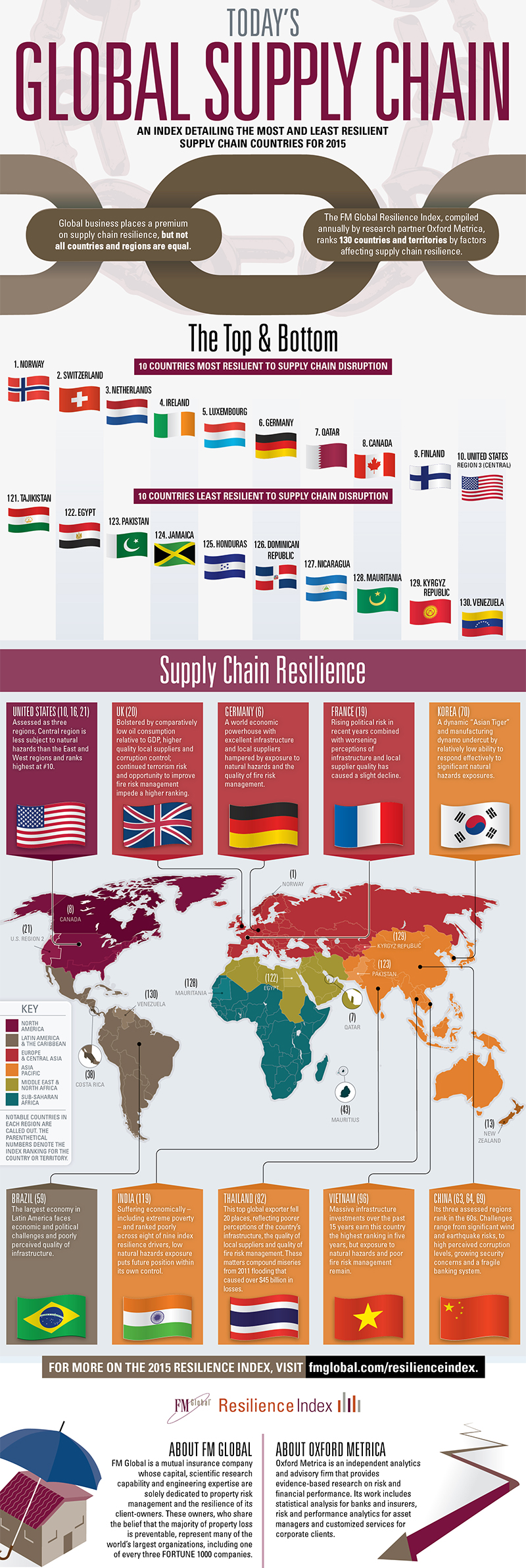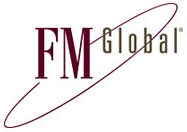Countries That Have the Most Resilient Supply Chains

Japan's manufacturing industry weathered the post-Fukushima crisis pretty well, all things considered, but other countries are less prepared for big disasters report says.
Where in the world is your company potentially vulnerable?
The 2015 FM Global Resilience Index is the first data-driven tool to rank the supply chain resilience of 130 countries and territories around the world to help executives prioritize where they should focus their risk management and investment efforts.
The index aggregates nine drivers of resilience into three factors - economic, risk quality and the supply chain itself.
With this tool, business decision-makers will be able to generate powerful insights about risk and opportunities in the supply chain as important elements to guide their operating strategy in four key areas:
- Selecting suppliers based on the supply chain risk/resilience of the countries in which they are located
- Deciding where to locate facilities
- Evaluating the resilience of the countries hosting existing facilities
- Assessing the supply chain resilience of countries where customers’ facilities are based
Key Findings
This year’s annual index rankings capture a fascinating mix of change and stability.
Norway, ranked 1, and Switzerland, ranked 2, hold the top places in the index. Norway achieves this with consistently high scores across the three core factors of resilience: economic, risk quality and the supply chain itself. Norway’s high score for risk quality depends strongly on minimal natural hazard exposure.
Switzerland scores highly on economic and supply chain factors (where the country leads). In particular, Switzerland scores best in the world for an extensive and efficient infrastructure.
Qatar, ranked 7, and Finland, ranked 9, are new to the top 10 this year. Qatar benefits from macroeconomic stability, efficient goods and labor markets, and a high degree of security. The country owes its jump in position to a considerable improvement in commitment to fire risk management in the region.
Finland’s strengths spring from its innovative capabilities which are the fruit of high public and private investment in research and development, strong links between academe and private sector companies, and an excellent record in education and training.
Most countries ranking in the bottom 10 score poorly on economic factors. Venezuela, ranked 130, placing it last in the 2015 index, is the victim of a challenging mix of an unstable macroeconomic environment, high inflation and public debt, and malfunctioning markets. Beyond economic factors, the country scores poorly in terms of risk quality and supply chain factors.
The index also identifies countries working hard to make themselves more attractive supply chain partners.
Taiwan, ranked 37, has jumped 52 places this year, more than any other country. Its rise is due mainly to a substantial improvement in the country’s commitment to risk management, as it relates both to natural hazard risk and fire risk.
Ukraine, ranked 107, and Kazakhstan, ranked 102, both fell 31 places this year, more than any other country. For Ukraine, this is due directly to the deteriorating political risk situation in the east of the country. For Kazakhstan, the cause relates to a poorer commitment to natural hazard risk management in the region than last year.
Thailand, ranked 82, has dropped 20 places this year due to supply chain factors - in particular, a poorer perception of both the quality of its overall infrastructure and the quality of its local suppliers.
The index also uncovers unexpected ranks for some major economies with active supply chains.
The Republic of Korea, for example, often deemed one of the most dynamic ‘Asian Tigers,’ is ranked 70, hindered significantly by its exposure to natural hazards, and by its relatively low ability to respond effectively to them.
Conclusions
With the help of the composite ranks and scores for each country, as well as the underlying scores for the nine drivers of supply chain resilience, business decision-makers can map their own current or planned operations and supply chains.
They can make more informed choices on how to manage their supply chain risk by weighing political factors and levels of corruption against natural hazard exposure and the quality of fire safety regulations.
The FM Global Resilience Index and The 2015 FM Global Resilience Index Annual Report helps determine exposures as well as clarify decisions about levels of supply chain redundancy.
By balancing supply chain needs with supply chain risk on an enterprise-wide, global level, companies in any industry can ensure that their business is resilient enough to withstand the inevitable threats to their supply chain and, by extension, enhance their competitive advantage in the marketplace.
Article Topics
FM Global News & Resources
2017 Resilience Index Annual Report How Does Your Supply Chain Resilience Rank? Understanding Supply Chain Resilience The 2015 FM Global Resilience Index Annual Report Countries That Have the Most Resilient Supply ChainsLatest in Supply Chain
U.S. Manufacturing is Growing but Employment Not Keeping Pace The Two Most Important Factors in Last-Mile Delivery Most Companies Unprepared For Supply Chain Emergency Microsoft Unveils New AI Innovations For Warehouses Let’s Spend Five Minutes Talking About ... Malaysia Baltimore Bridge Collapse: Impact on Freight Navigating TIm Cook Says Apple Plans to Increase Investments in Vietnam More Supply Chain















